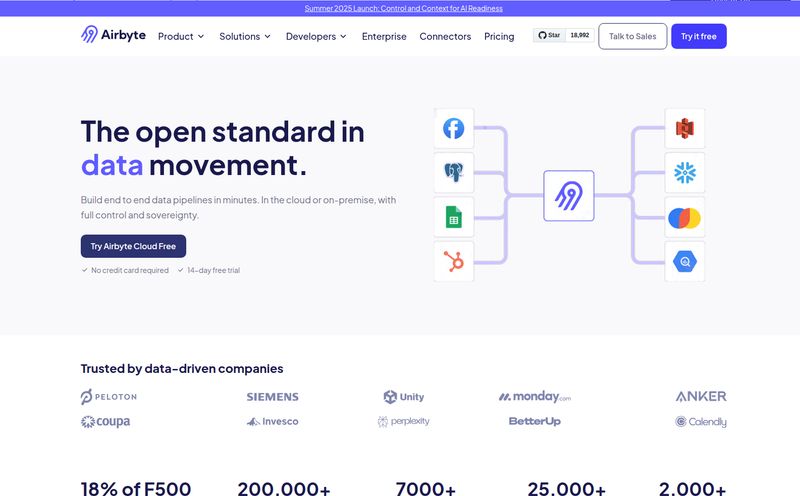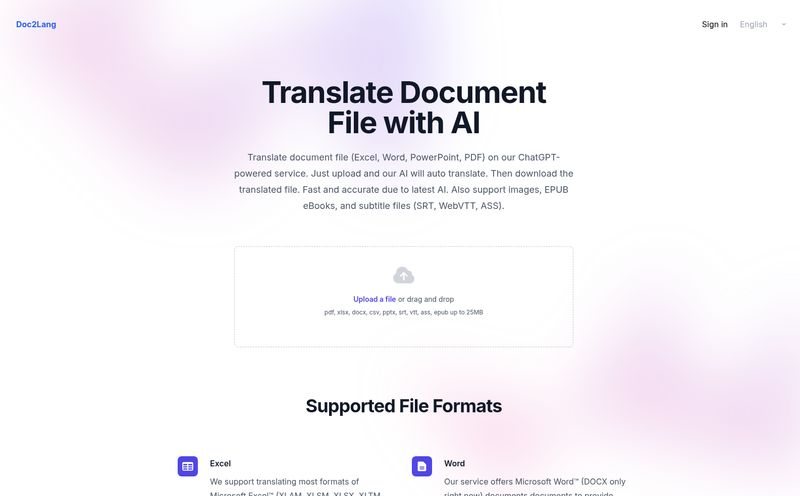Is This The End of 'Ctrl+F' As We Know It?
If you're anything like me, your digital life is a carefully curated mess. We're talking folders inside of folders, a desktop that looks like a digital collage, and a 'Downloads' folder that's basically a black hole. My work as an SEO and content person means I'm constantly swimming in a sea of documents. Market research reports, competitor analysis PDFs, client briefs in DOCX, and about a thousand saved articles. It's organized chaos, but chaos nonetheless.
For years, my primary tool for navigating this digital swamp has been the trusty Ctrl+F (or Cmd+F for my Mac friends). It's simple. It works. But it's also… dumb. It can't find concepts, only exact words. It can't read a scanned 50-page contract from 2008. And it certainly can't compare insights from three different reports at once.
I've seen dozens of AI tools pop up promising to fix this. Chat with your PDF! Summarize your documents! Most are okay. Some are decent. But I hadn't found one that felt like a true step up from my old-school methods. Until I spent a week with FileGPT. And I have to say, this one feels different. It feels like someone actually understood the problem.
So, What Exactly is FileGPT?
Forget the fancy marketing jargon for a second. At its heart, FileGPT is like giving your files a brain. It’s a GPT-powered application that lets you upload a whole bunch of different file types and then… just talk to them. Ask questions in plain English. Get answers. It’s less like a search tool and more like having a conversation with a hyper-intelligent research assistant who has already read every single one of your documents for you.
You can throw pretty much anything at it: standard PDFs, Word documents, text files, even webpages and YouTube videos. It ingests the information and turns it into your own personal, searchable knowledge database. No more endless scrolling. No more scanning for keywords. Just ask, “What were the Q3 revenue projections from the marketing report?” and it tells you. It’s the kind of thing that sounds like science fiction but is now, thankfully, just good software.

Visit FileGPT
The Features That Actually Make a Difference
Every tool has a features list as long as your arm. But most of those features are fluff. Here’s the stuff in FileGPT that I found genuinely useful in my day-to-day grind.
It Speaks More Than Just 'PDF'
The first thing that caught my eye was the sheer range of supported formats. Sure, it does PDFs and DOCs like everyone else. But adding YouTube videos, audio files, and webpages to the mix? That’s a game-changer. I recently had to pull insights from a 90-minute webinar on YouTube. Instead of scrubbing through the video and taking manual notes, I just gave the link to FileGPT. A few minutes later, I could ask it specific questions about the content. “What did the speaker say about Google's latest algorithm update?” Boom. Answered, with context. Its a huge time saver.
Finally, OCR That Doesn't Make Me Want to Cry
If you've ever dealt with scanned documents, you know the pain. They're just flat images of text. You can't search them, you can't copy-paste from them. It's a nightmare, especially with older contracts or academic papers. FileGPT has Optical Character Recognition (OCR) built in, and it's surprisingly good. I tested it on a few grainy, poorly scanned PDFs from my archives, and it managed to pull the text out with impressive accuracy. This feature alone makes it worth looking at for anyone in legal, academic, or corporate research.
The Multi-File Magic Trick
This is the real showstopper for me. The ability to perform cross-source querying. In plain English, you can upload multiple files at once and ask questions across all of them. Think about that. You have a financial report, a marketing plan, and a transcript from a sales meeting. You can upload all three and ask, “Based on all these documents, what are the biggest risks to our Q4 launch?” FileGPT will synthesize information from all three sources to give you a coherent answer. I've been waiting for this for years! It’s the difference between having ten tabs open and trying to connect the dots yourself versus having an assistant do the heavy lifting for you.
How It Stacks Up Against the Competition
Look, the “Chat with your PDF” space is getting crowded. Tools like ChatPDF and ChatDOC have been around for a bit, and they’re fine for simple tasks. If you just need to summarize a single, clean PDF, they'll get the job done. But in my experience, they hit a wall pretty quickly.
Where FileGPT pulls ahead is in its robustness. It's built for bigger, more complex tasks. It handles larger files and much longer texts without choking. The multi-file querying I just mentioned is something the simpler tools just can't do. I’d consider ChatPDF the handy pocket knife, but FileGPT is the full-on Swiss Army knife with all the attachments. It's just a more powerful, more flexible platform for anyone doing serious work.
Let's Talk About the Price Tag
Alright, the all-important question: what's it going to cost? FileGPT runs on a tiered subscription model, which is pretty standard for these kinds of services. The AI processing behind this stuff isn't free, after all.
Here’s a quick breakdown of their yearly plans:
| Plan Name | Price (Yearly) | Best For |
|---|---|---|
| Basic | $100 | Students, researchers, and casual users. |
| Pro | $180 | Professionals and freelancers with heavy needs. |
| Growth | $480 | Small teams and growing businesses. |
| Elite & Enterprise | $980+ | Larger organizations needing custom solutions. |
My take? The $100/year Basic plan is a great starting point for students or anyone who just needs to wrangle personal research projects. But for professionals like me, the $180/year Pro plan is probably the sweet spot. It gives you more breathing room for larger and more frequent tasks. When you calculate the amount of time it saves, that price starts to look pretty reasonable.
No Tool is Perfect, Right?
I wouldn’t be giving you an honest review if I didn't mention the downsides. While I'm pretty high on FileGPT, it's not without its quirks.
First, there's a bit of a learning curve. Not a steep one, but you have to learn how to ask questions effectively to get the best results. It's more about learning to prompt well than navigating the interface. Second, the really powerful features require an upgrade. The free or entry-level access is fine for a test drive, but if you want to make this a core part of your workflow, you'll need to open your wallet. That's just the reality of the business model. Lastly, some smaller features, like an in-app document preview, are apparently still being polished. Not a deal-breaker for me, but something to be aware of.
"It's less a replacement for thinking and more a powerful amplifier for it. It handles the tedious so you can focus on the strategic."
My Final Take: Is FileGPT Worth Your Time and Money?
So, after all that, what's the verdict? Yes, I think it is. For the right person.
If you're a student drowning in research papers, a lawyer sifting through case files, a marketer analyzing reports, or frankly, anyone whose job involves extracting knowledge from dense documents, FileGPT is a massive upgrade to your workflow. It doesn’t do the thinking for you, but it removes an incredible amount of friction. It handles the tedious part—the finding, the sifting, the collating—so you can focus on the actual thinking and strategy.
It’s not magic. It’s a tool. But it’s a damn good one. It’s one of the first AI document tools I’ve used that feels like it was built for power users, not just as a novelty. It's earned a permanent spot in my digital toolbox.
Frequently Asked Questions
- 1. What is FileGPT in simple terms?
- FileGPT is an AI-powered tool that lets you upload your files (like PDFs, Word docs, audio, YouTube links) and ask them questions in plain English. It acts like a smart search engine for your personal documents.
- 2. What file types does FileGPT support?
- It supports a wide variety, including PDF (both regular and scanned via OCR), DOC, TXT, audio files, YouTube videos, and webpages. This is one of its main strengths compared to other tools.
- 3. Is there a free version of FileGPT?
- There's typically a free or trial tier that allows you to test the basic functionality with some limitations on file size or the number of questions. For heavy or professional use, you'll need one of the paid plans.
- 4. How is FileGPT better than a tool like ChatPDF?
- While ChatPDF is great for single documents, FileGPT is designed for more complex tasks. It supports more file types, handles much larger texts, and most importantly, allows you to ask questions across multiple documents at the same time.
- 5. Is my data safe with FileGPT?
- Data security is a major concern with AI tools. You should always review the platform's latest privacy policy. Generally, reputable services like this use secure protocols, but never upload highly sensitive personal information that you wouldn't want stored on any cloud service.
- 6. How does the OCR for scanned documents work?
- The OCR (Optical Character Recognition) technology scans the image of the document, identifies the letters and words, and converts them into machine-readable text. This allows you to search and query the content of a document that was previously just a static image.



